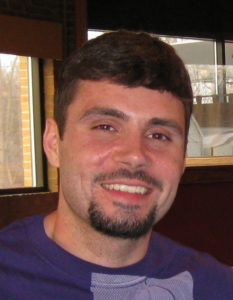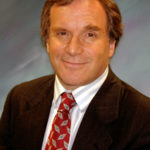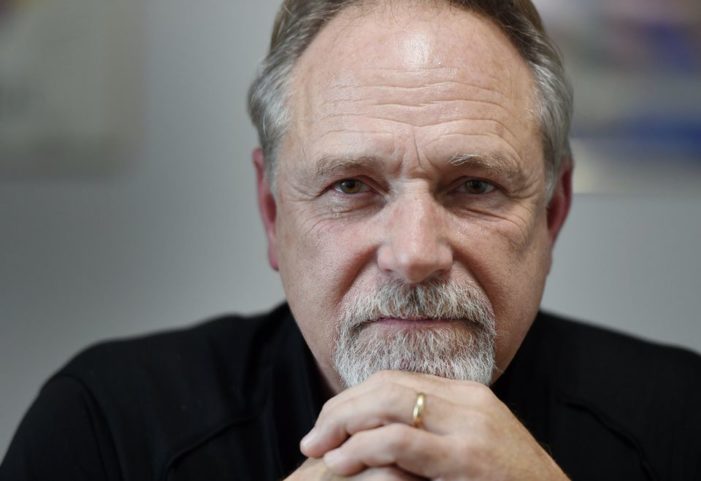Before Mike Hirst speaks to audiences he reaches for an urn and chokes back emotions.
“My son would love to tell you this story that I’m going to tell you, but he can’t because he resides here in this little urn as a pile of ashes,” Hirst says. “These will be some of the most important words you’ll ever hear, if you pay attention. If you don’t, you’ll end up like my son – a little pile of ashes.”
Father and addiction education advocate Mike Hirst brings his son’s ashes to his presentations as a reminder that addictions are deadly.
Hirst’s son, Andy, loved playing basketball, football and PlayStation video games. He was popular and, nearly every evening, he invited friends home for dinner. Andy changed, though. Sports and friends no longer interested him. He became quiet and isolated. He stopped caring about his appearance.
Andy was addicted to OxyContin and eventually started injecting heroin.

Neither jail nor treatment could stop his addiction before he died nearly seven years ago in a construction site outhouse with a needle in his arm. He was 24.
Hirst shares his pain with children, parents, politicians, police and others who are working to find solutions to stem the national epidemic of heroin use that typically begins with abuse of prescription painkillers.
“I don’t want to see any more kids like my son,” says Hirst, founder of the Jackson-based Andy’s Angels Foundation, a grassroots nonprofit organization that runs a support network for recovering addicts and people with loved ones addicted to opiates and heroin. “I knew what was going on, but I got involved too late to save my own son. I figured I could save others.”
He’s encouraged by a $16.37 million federal grant recently awarded to the Michigan Department of Health and Human Services (MDHHS) to help reduce opioid use and abuse across the state.
“The addiction epidemic continues to impact families in every community across our state and across this country,” Lt. Gov. Brian Calley said in a statement. “Michigan is making strides in the fight against addiction and this grant will help us bring those efforts to the next level, helping more families find the support they need to prevent and treat addiction.”
From 1999 to 2014 Michigan saw a four-fold increase in unintentional fatal drug poisonings, and the state was ranked 10th in the nation for per capita prescribing rates of opioid pain relievers in 2012.
Hirst understands firsthand how the crisis impacts families in Michigan and across the nation.
From 1999 to 2014 Michigan saw a four-fold increase in unintentional fatal drug poisonings, and the state was ranked 10th in the nation for per capita prescribing rates of opioid pain relievers in 2012.
“There is certainly an epidemic going on and the amount of people affected by this is staggering,” Hirst says. “There are not enough beds to go around. Most of the treatment centers operate on shoe-string budgets. A lot of the recovery resource facilities are operating on donations and limited funds.”
About 80 percent of the (MDHHS) funds will go toward treatment; the other funding will aim efforts at prevention, research, education and help build a long-term, comprehensive state plan to stem the number of opiate and heroin overdoses.

Dr. Jed Magen, an associate professor and chairman of the Department of Psychology at Michigan State University who treats opiate users, says the additional funding for treatment is essential.
“Absolutely, we need more treatment resources for people,” he says. “It’s a whole lot less expensive to treat people than it is not to treat them or to put them in jail.”
Treatment usually involves getting a person off opiates, typically by using another drug to wean them away from drugs such as OxyCotin, Percocet, Vicodin or heroin. The difficult part, Magen says, is keeping them from using once they’ve gone through treatment.
“It’s like a hunger almost,” Magen says. “If you’re really hungry and go to the refrigerator and you look and you can’t find what you want. You wander around a little bit and you go back. You have this drive to keep looking.
“With addictions, there are neurobiological changes that go on in the brain, which cause intense cravings. They can say, ‘I know I shouldn’t do this.’ But it’s a craving that gets them into trouble, and often happens when they’re back in similar situations when they used in the past.”
Magen says many more people who are addicted to opiates started with physicians because, for a long time, physicians were told they should treat pain with opiates like OxyContin, Hydrocodone, Vicodin.”

Michigan State Police Lt. Lisa Gee-Cram, who is working on the epidemic from a law enforcement perspective, says the problem won’t be addressed by criminally penalizing offenders.
“We’re not going to arrest our way out of this and we can’t cut the head off the snake,” she says. “You arrest one and I promise there are two to take their place. We have to reduce the need for the drug on the street. We have to do that through treatment and education.”
To that end, the state police recently started a pilot effort, the MSP Angel Program, which gives opiate users priority admission to treatment centers when they go to a state police post. The program is slated to become statewide by the end of the year, Gee-Cram says.

The first responsibility of friends and relatives of users is to immediately intervene when they learn about the addiction, Hirst says.
“We can’t hide, be ashamed or embarrassed to talk about it,” he says. “We can’t be afraid to do something, because the next time they use could be their last.”
See other addiction-related coverage in TheHUB:
Michigan launches media campaign to reverse opioid addiction
Opioid abuse explosion brings new opportunity for solutions, health agency says


